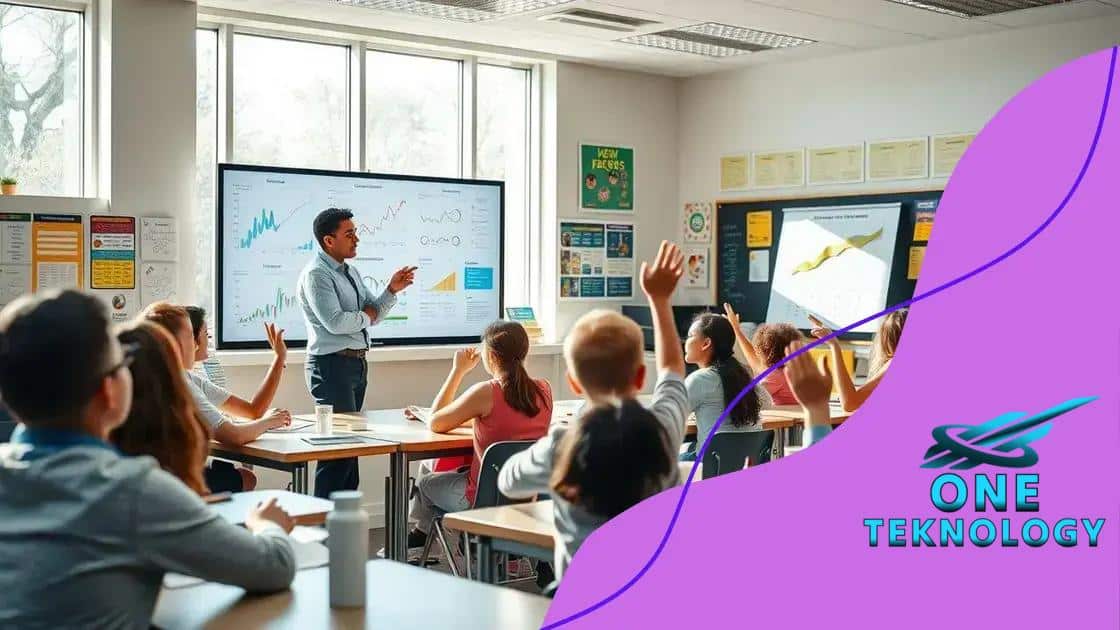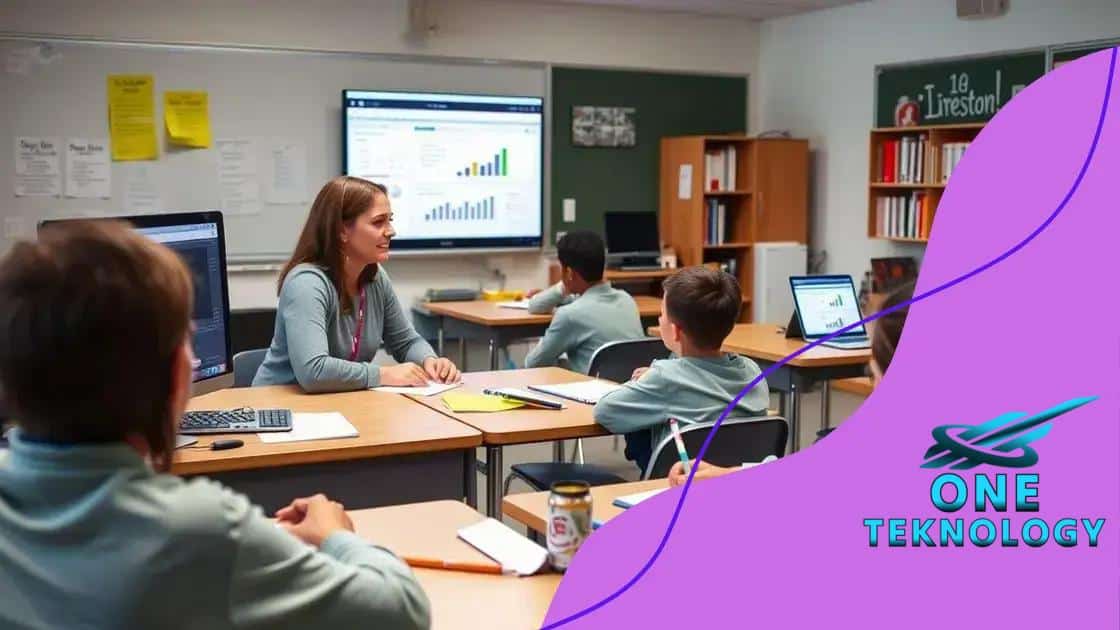How schools are using data analytics to improve student outcomes

Data analytics in education enhances student outcomes by enabling personalized learning experiences, tracking progress effectively, and fostering community involvement, leading to improved academic performance and student engagement.
How schools are using data analytics to improve student outcomes is a vital topic in today’s educational landscape. With data-driven decisions, educators can better meet students’ needs and enhance their learning experiences.
Understanding data analytics in education
Understanding data analytics in education is crucial for modern learning. It helps schools track progress and identify areas where students need support. With the right tools, educators can transform raw data into actionable insights.
Data analytics offers a clear view of student performance. By analyzing test scores, attendance, and participation, schools can pinpoint issues early. For instance, a student’s declining grades in math could indicate a need for additional tutoring. This way, help can be tailored to fit individual needs.
The importance of real-time data
Real-time data allows teachers to adjust their methods promptly. By monitoring assessments, feedback can be immediate.
Key benefits of data analytics in education
- Customized learning experiences that fit each student’s pace.
- Data-driven decisions that enhance teaching strategies.
- Identification of trends that inform curriculum development.
- Empowerment of students by providing insights into their learning styles.
As students interact with various learning tools, analytics capture these experiences. This information enables teachers to refine their approach and improve engagement. For example, if many students struggle with a specific topic, educators can rethink their teaching strategy.
Ultimately, data analytics bridges the gap between teaching and learning. By utilizing trends and patterns in data, schools create a more responsive educational environment. This not only boosts student achievement but also fosters a love for learning.
Real-time insights for improved teaching
Real-time insights for improved teaching are crucial for creating effective learning environments. These insights allow educators to see how students respond during lessons. By tracking participation and comprehension, teachers can make adjustments on the fly.
When teachers have access to real-time data, they can tailor their teaching methods to better meet the needs of their students. For example, if a large number of students struggle with a particular concept, the teacher can revisit it immediately, ensuring no one falls behind.
The role of technology in real-time insights
Technological tools play a significant role in gathering and analyzing data.
- Interactive learning platforms provide instant feedback.
- Assessment tools evaluate student understanding during lessons.
- Data dashboards highlight trends and patterns in student performance.
Using these technologies, teachers can foster a more engaging classroom. Instead of waiting for end-of-term assessments, they can implement changes based on observations in real time. This allows for a more dynamic approach to instruction.
Benefits of real-time insights
Employing real-time data contributes to a more personalized learning experience. Teachers can identify which students need extra help and which are excelling. This ensures that all students are supported appropriately.
As a result, real-time insights drive improvements in both teaching and learning. They create an environment where teachers can respond promptly, enhancing overall educational outcomes and helping students thrive.
Personalized learning through data analysis

Personalized learning through data analysis is revolutionizing education today. By using data, teachers can create tailored experiences that suit individual student needs. This approach goes beyond one-size-fits-all methods.
When data is collected and analyzed, it reveals unique student patterns. For example, a student who excels in reading but struggles with math can receive specific resources aimed at improving their math skills. This laser-focus helps maximize their learning potential.
The process of personalization
Data analysis enables the customization of learning materials.
- Identifying strengths and weaknesses allows for targeted instruction.
- Tracking learning styles helps in offering diverse resources.
- Adjusting pacing according to student progress enhances the learning experience.
Moreover, personalized learning promotes student engagement. When students see their data reflected in their learning paths, they feel more invested in their education. This proves beneficial, as motivated students tend to participate more actively in their lessons.
Tools for data-driven personalization
Many technology tools facilitate personalized learning through data analysis. Learning management systems often include options for tracking student performance. Teachers can utilize these tools to adjust lessons quickly based on real-time feedback.
As students navigate their learning journey, insightful data reinforces the importance of personalized education. They are much more likely to thrive when learning paths are designed specifically for them. In essence, personalized learning through data analysis creates a more responsive education system.
Tracking student progress effectively
Tracking student progress effectively is essential for improving educational outcomes. By regularly monitoring how students are doing, educators can identify areas that need attention. This leads to better support and resources for each student.
Data collection methods, such as quizzes and assessments, are vital for understanding student performance. Teachers can use this information to adjust their teaching strategies and provide targeted help. For instance, if a student struggles with reading comprehension, a teacher can offer specific exercises to boost their skills.
Methods for tracking progress
There are several effective methods to track student progress.
- Standardized tests give a broad view of student abilities.
- Formative assessments help gauge understanding during the learning process.
- Learning management systems provide real-time data on student engagement.
By analyzing this data, teachers can see trends over time and make informed decisions. For example, if multiple students have low scores in a specific area, that topic can be revisited. This flexibility ensures that learning is always aligned with student needs.
The impact of timely feedback
Timely feedback plays a crucial role in student development. When students receive immediate feedback on their work, they can understand their mistakes and learn from them right away. This is more effective than waiting for end-of-term evaluations.
Moreover, continuous tracking encourages student ownership of their learning. Students who see their progress are more likely to stay motivated. They can set goals and celebrate milestones as they improve.
Overall, tracking student progress effectively leads to a supportive and adaptive learning environment, helping students achieve their best.
Case studies of successful data use
Case studies of successful data use provide valuable insights into how schools can improve student outcomes. These real-world examples illustrate the power of data analytics in transforming education.
One notable case is the implementation of data tracking in a large urban school district. By analyzing student performance metrics, educators identified trends indicating that students struggled with math in certain grades. In response, they created targeted intervention programs that resulted in a 20% increase in math proficiency over two years.
Example: Personalized Learning Programs
Another example comes from a charter school that utilizes data analytics to personalize learning. The school developed a system that gathers information on student progress through regular assessments. This data lets teachers customize lesson plans and adjust pacing to fit individual learning needs.
- Students receive tailored lessons based on their strengths and weaknesses.
- Regular check-ins allow for immediate feedback and support.
- The school reported higher engagement and improved test scores.
These programs benefit not just struggling students but also those who excel, ensuring all learners receive the appropriate challenge. By fostering an environment where data drives instruction, schools can help every student succeed.
Community Engagement through Data
An example from a rural school shows how data can engage the community. The school district collected data on student attendance and performance, then shared the findings with parents and community members. Workshops were held to discuss how home environments affect learning.
This initiative led to stronger partnerships between schools and families, improving attendance rates and creating a supportive network for students. When stakeholders work together using data, the entire community benefits.
In conclusion, case studies of successful data use highlight the potential of data analytics in education. By learning from these examples, other schools can adopt similar strategies to enhance their own student outcomes.
In summary, leveraging data analytics in education is a powerful way to enhance student outcomes. Schools that effectively track progress and implement personalized learning can create supportive environments where all learners thrive. With examples of successful strategies, it’s clear that when data drives instruction, the whole community benefits. By adopting these practices, educators can ensure every student receives the attention and resources they need to succeed.
FAQ – Frequently Asked Questions about Data Analytics in Education
How can data analytics improve student outcomes?
Data analytics helps identify student strengths and weaknesses, allowing for personalized instruction that meets individual learning needs.
What tools are best for tracking student progress?
Learning management systems, assessment software, and real-time feedback tools are effective for tracking progress and engagement.
Why is personalized learning important?
Personalized learning engages students more effectively by addressing their unique learning styles and challenges, leading to better outcomes.
Can data help foster community involvement in schools?
Yes, sharing data with parents and community members can strengthen partnerships, enhance communication, and improve student support.






